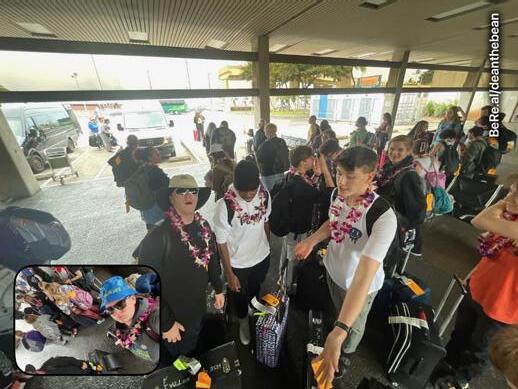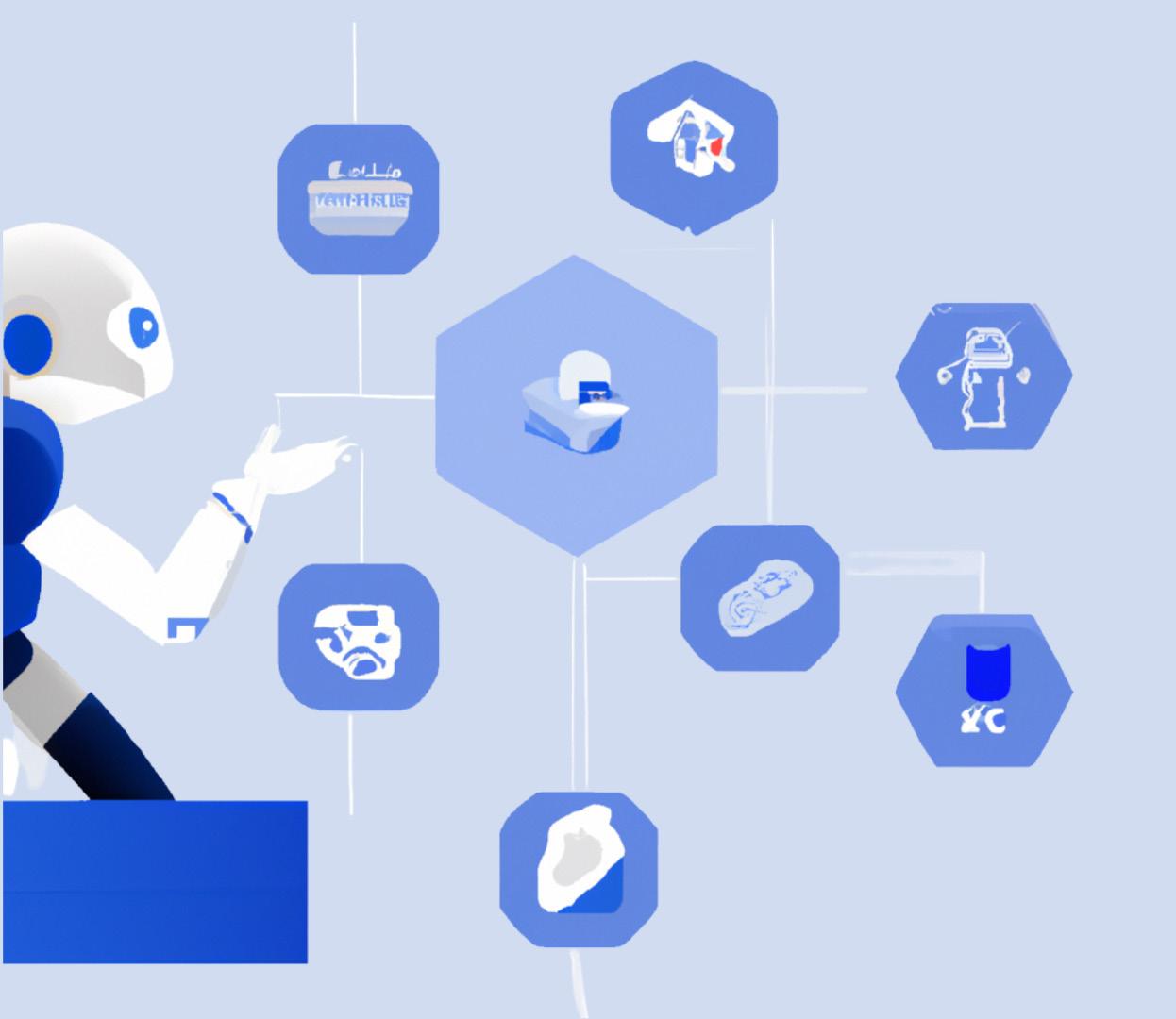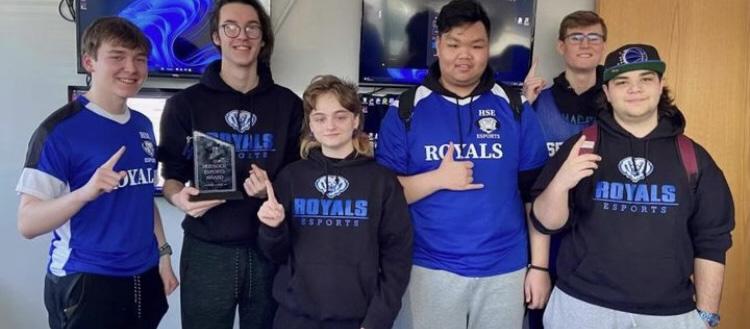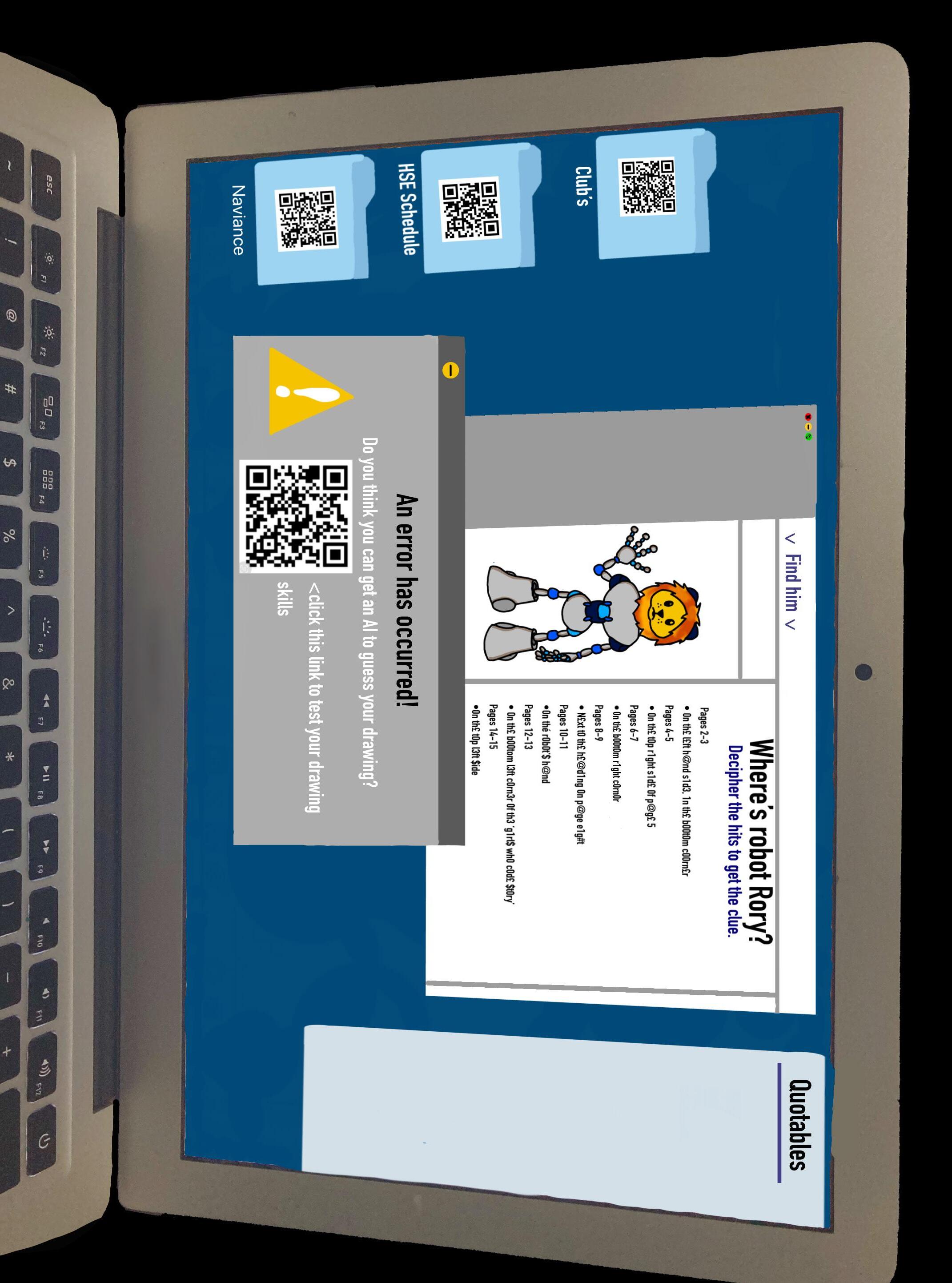THE DIGITAL ISSUE
Pg 5 - Keeping It Real by Sydney
Pg 7 - Internet Indictment by
Pg 8 - AI Invasion
Pg 13 - Rise of ChatGPT in Classrooms by
 by Ben Kruer, Charlotte Mishka and Caroline Hiott
Nicole Mathenge
Pynchouck
by Ben Kruer, Charlotte Mishka and Caroline Hiott
Nicole Mathenge
Pynchouck

Pg 5 - Keeping It Real by Sydney
Pg 7 - Internet Indictment by
Pg 8 - AI Invasion
Pg 13 - Rise of ChatGPT in Classrooms by
 by Ben Kruer, Charlotte Mishka and Caroline Hiott
Nicole Mathenge
Pynchouck
by Ben Kruer, Charlotte Mishka and Caroline Hiott
Nicole Mathenge
Pynchouck
Cassidy Hayes
Paityn O’Neill
FEATURE EDITOR
Lauren Kopka
-
Code
Zach Beason
STAFFER OF THE ISSUE
Nicole Morris
ADVISER
COPY EDITOR STAFFERS
Emma Bieberich
Annabella Burns
Sornavalli Chockalingam
Kaiden Corliss
Xavier Dokes
Grace Duffy
Mame Fall
Parker Farrand
Addison Ginther
Jordyn Grant
Avery Grunder
Marley Hayes
Gabriella Haynes
Caroline Hiott
Benjamin Kruer
Erin Lock
Trinity MacKenzie
Aubrey Matasovsky
Nicole Mathenge
Trestyn Mayberry
Caio Menegardo
Charlotte Miksha
Madelynn Page
Maya Patel
Sydney Pinchouck
Amber Rivas
Aria Roberts
Mackenzie Roberts
Katherine Senseman
Hannah VanLandingham
Julianna Wells
Norah Wills
There is a common saying that humanity fears what they do not understand. In this issue, we sought to understand and explain one of the most misunderstood and thus feared topics today: artificial intelligence.
This issue is not only about AI. The Digital Issue covers a variety of digital issues that we as a generation are grappling with today. From Nicole Mathenge’s interview with English department chair Amy Shipley to debates about AI soccer referees, every article is wrestling with the digital issues of our day.

We have also tried to explore many of these new tools for ourselves. For example, the cover is a photo made by DALLE-2, a photo generation AI service. AI assistance has been utilized throughout the issue to help generate interview questions, create headline ideas, and brainstorm article topics.
It also marks a new beginning. Starting today, the Orb’s stories will be featured on our website and social media accounts, in addition to print. Our Instagram, @ hsenews, and our website, hsenews.com, will be updated with every issue.
Society is becoming increasingly digital. It is about time that our newsroom takes the first click along with it.
Rhona St. Hilare - Rhonda St. Hilare
Stevani McCray - Stevanni McCray
Secondly, the printed issue of the Orb contained the incorrect version of this story, to access the correct version go to issuu.com/hsenews.
We strive to improve on our quality for all future publications, thank you for your understanding. As student journalists we are always learning from our mistakes to ensure we bring you the highest quality publications as possible.
- Cassidy Hayes, Orb Editor-in-Chief


Nealon Shah’s eyes scan hundreds of lines, looking for any possible spelling errors, missing parentheses or missing symbols. The screen reflects on Shah’s glasses as Shah scrolls up and down the code. Shah’s mind is constantly analyzing what has been made, trying to find anything that could keep the creation from running smoothly. This process is the most tedious part of coding, but Shah, a junior at HSE, takes it as a challenge.
In freshman year, there was an extra spot in Shah’s schedule and decided to use it to try out AP Computer Science Principles, even with no prior coding experience. Shah knew getting by in the class would not be impossible, but it was unknown how much this decision would end up meaning to Shah.
Since taking that first Computer Science class, Shah has taken two more and participates in the Computer Science Honor Society in his free time. To dive even deeper into it, Shah tutors other students in the subject a learning opportunity for both Shah and the students who need assistance.

Kari Richardson, a Computer Science (CS) teacher at HSE, hosts Shah’s tutoring sessions.
“I have come to know Nealon as a strong student and a role model to his peers at HSE,” Richardson said. “He leads with integrity, is a stellar student in the classroom, works to help others
grow through tutoring and has a passion to give back to his community.”
After indulging in the subject, Shah realized that by pursuing it as a career, it would make CS a very important part of life. Shah plans to major in CS in college and wants to become a software or Artificial Intelligence engineer after that, focused on AI that solves problems and helps those in need.
“I think AI has the potential to help kids and adults in developing nations get an advanced education at little to no cost,” Shah said. “I hope we can use AI as an assist to empower humans instead of as a replacement for human intelligence.”

Shah will continue to learn more and more about CS and AI through his junior and senior year, throughout college and in the career path chosen. Shah’s goal is to make an impact in AI for years or decades to come. Story by
Aria Roberts.After graduating from HSE in 2016, Summer Pratt attended a Java software development bootcamp based out of Carmel. Pratt was on the HSE Sceptre team for three years, two as an editor, and now is a website design and development consultant. Her experience with Student Media, learning many design skills such as Adobe Photoshop and Illustrator, set her on the path to her successful career. She also learned the importance of taking responsibility for your work and delivering a highquality product. Pratt appreciates the preparation that Student Media gave her and the passion she found for photography and visual design. Because of this, she went on to join the workforce rather than attending college.
The company she worked for out of high school provided her with real-world experience. She was able to meet new people and grow her personal network. While her path may have looked different from many others in her graduating class, she is satisfied and happy with where she ended up.
Pratt advises anyone on a similar path that a great network is valuable to starting a company. Pratt also believes that knowing your passions is most important to live a happy life.
“I think it’s important to ask yourself what you want your life to look like,” Pratt said. “Selfawareness will make you happier.”
Story by Sydney Pinchouck and Hannah Vanlandingham and contributions from Annabella Burns.Technology is constantly evolving and influencing various aspects of everyday life, from the smartphones picked up and used everyday to the work done on laptops instead of paper. Movies are a common product of technology that many people enjoy daily. Generally, when the making of movies is brought up in conversation, cameras out of sight and microphones overhead are what people imagine. For many years, this has been the reality and has intrigued many who aspire to become filmmakers. While this still holds true, a new method of filming movies has emerged from the realities of today’s technology. When a phone snaps a picture, a microphone captures a sound, or a laptop is turned on, the real world lives of users are left open to the widespread exploitation of technology. Instead of filming with traditional cameras that give viewers a third person point of view, filmmakers have started filming with smartphones, webcams, and other personal devices that give the viewer a relatable first person point of view. This new filming method, coined by Russian director and producer Timur Bekmambetov as ‘Screenlife,’ has become widely relevant to technology in everyday life because of its exclusive use of everyday technology such as smartphones, personal cameras, webcams and more. Bekmambetov coined the term for his 2014 film “Unfriended”, which was filmed via a computer screen as a Zoom call takes place. The 2018 screenlife film “Searching” showcases this method of filming in its use of GoPros, drones, mini DV cameras, webcams and iPhones. Just this year, “Missing”, another screenlife film, was filmed entirely on computers, cellphones, smartwatches, security cameras and more. While these movies present a new way for filmmakers to create relevant storylines, the relevancy of the method itself is a harsh realization of how technology is nearly everywhere on a daily basis and how that same technology could be gathering information without users ever knowing. Story by Avery Grunder.
In recent years, the argument of whether artificial intelligence is an advancement or hurtful to our society. The first form of AI was created in 1951 in England by Christopher Strachey. AI is the theory of computer systems performing tasks normally completed by humans by using like-human intelligence. AI has rapidly evolved into integrating in all parts of our everyday lives and routines. An important question being discussed: is AI helping or hurting our society?
AI has done incredible things for the advancement of society, especially in industry. It is beneficial for keeping companies’ economic strength dependable by completing tasks faster and more efficiently. Economically, AI is extremely beneficial for most businesses with the analysis of their data at rapid speeds, helping analysts make decisions and come up with strategies. AI robots owned by companies do not need breaks or vacation days. They run consistently and constantly, making no human errors in the products. Another benefit of AI is the major advancements in technology. It improves the functioning of society with virtual assistants like Siri and Alexa, facial recognition in modern phones and GPS navigation and self-driving cars. In the field of healthcare, AI has led to advancements in personalized treatments, analyzing symptoms and helping to maximize hospital efficiency.
Although it is clear that AI has done some amazing things for our society, there is also a cost. Artificial IntelligenceAI has the potential to take away factory jobs that many middle-class families depend on. Failure in AI systems can lead to leaks of private information. In addition, AI technology makes decisions based on a programmed algorithm. In situations such as self-driving cars, AI would make the logical choice. AI is incapable of making a decision based on human emotion, which could lead to horrible consequences.
All this being said, the question remains - is AI truly helping or hurting society? With knowledge gathered from AI, societal benefits because of Artificial Intelligence AI outweigh the potential repercussions. Story by Katherine Senseman.


BeReal is a popular social media platform originally released in 2020 designed to keep social media “real.” It did not reach peak popularity until 2022, now having over 21 million users. With it being marketed as the internet’s only “real” visual media, many people were intrigued. Each day, users have two minutes to take and post one photo, taken from the front and back facing cameras. All users post a photo at the same time, and followers can see if the post was late. The goal of the app was to prevent people from having time to stage photos and posts. Users enjoy trying to post on time to stay “real” and it has grown into a common place of communication for many people. It keeps people from staging their posts, allows people to see what their friends are truly doing in that exact moment and is an all-around fun platform to be on that serves its intended purpose. Story by Sydney Pinchouck. Photos contributed via @hsenews Instagram.




At the start of March 2023, users with Snapchat+ got an update. When Snapchat users open their phone, a new pin will come up about a new AI feature.

“My purpose is to assist you with any question or concerns you may have while using Snapchat,” My AI said.
The AI manages typical bug issues a user would like to report or resolve, however, its functionality is not limited to just troubleshooting. As it helps tech issues on Snapchat, it can also hold regular conversations with users along with giving advice on subjects like school and

relationships.
The staff tested its features with an example question of how to stay motivated. “Staying motivated can be tough, but there are a few things you can try to help keep yourself,” My AI said. “A couple things you can do is break your work in to smaller more manageable tasks, try rewarding yourself after doing a task, and more!”
With AI services being added to social media apps, be on the lookout for an increased usage of AI in everyday life. Story by Marley Hayes.




Today, technology is embedded everywhere in our lives with one of the biggest areas being law enforcement. For instance, the Fishers Police department is soon to become one of the largest departments in Indiana to start using body-worn cameras. Many feel this is a significant improvement from where the police started before. This is becoming a common occurrence for departments across the US.
The Washington Post wrote, “In their daily work, [police officers] are using drones, license plate readers, body cameras and gunshot detection systems to reduce injury and bodily harm.” Indicating that in some of the many ways, technology is currently embedded in law enforcement.
Kevin Sutton, HSE High School’s Safety Resource Officer, has been a police officer for 23 years and an SRO for 12 years. He believes that the police have come a long way with technology in positive ways.

“Streamlining of DNA tests, tactical tools such as drones and GPS have
made tactics safer and much more efficient,” Sutton said. “When I started [in] my old department we were still using paper reports.”
Decades ago, law enforcement did not have the resources available today like DNA tests, which are important to solving crimes that involve DNA left at the scene and more. Using DNA evidence in crime cases may also be an effective approach and lead to a greater number of identified suspects than the traditional methods. DNA testing is faster and leads to more cases solved in the example of rape and murder than the original methods that heavily relied on fingerprints and shoe prints.
Technology not only helps the jobs of police be more efficient, but it also assists in protecting the officers and citizens. The high-profile policerelated deaths of Black Americans resulted in citizens demanding body cameras for more transparency and honesty, causing the officers to own to their mistakes and take responsibility. However, there can be a negative side to modern technology. In the
As technology becomes more prevalent, it has been determined that many of the Orb’s stories will now include social media updates. You can now read Orb stories on the HSENews website. The Student Media team will frequently make art connected to the stories on the website. The team also wants the stories to reach more HSE students, who are our target audience. The Student Media social media team will help by publishing the storyrelated art on HSE social media in order to increase the engagement with stories since HSE students use online apps like Instagram. Story by Xavier Dokes.
death of George Floyd, officer Derek Chauvin’s body camera was on, revealing Floyd’s last words, “I can’t breathe.”
The body camera was one piece of evidence from the act Chauvin committed, sentencing him to 22.5 years in prison.
The new technology is made to protect citizens and its officers, but when turned off in the moment during the murder of George Floyd completely disregards the main purpose of the body camera.
In addition, phone apps like Waze, a GPS map app like Google Maps, can show the location of the on-duty police officers. Kidnappers can dodge the police based on their tracked presence on Waze, making it harder to catch them. Technology is a tremendous help to the law enforcement, but at times it can turn against them in situations that involve criminals that know how to use the internet. Overall, though technology over time has improved drastically, making the jobs of police officers much easier and efficient. Story by Jordyn Grant.

“When I started [in] my old department, we were still using paper reports.”
- Kevin Sutton, Police Officer
Internet sleuthing and citizen investigators have become increasingly popular in recent years, mirroring the growth of true crime podcasts and internet series such as Buzzfeed Unsolved. Due to this rise in popularity, new light has been shed on its effect on criminal investigations and the people involved. While many argue that these groups of sleuths are harmless and entertaining, even helpful in some cases, many others argue that it desensitizes people to violence and may force law enforcement to hasten plans or even complicate their investigations more than necessary.
A rise in popularity of various cold cases and crimes on the internet provides a new source of entertainment for the average user. Web sleuthing is when groups of users, who are not trained in investigative methods or skills, observe the details of a case in an attempt to provide more information or evidence to the public or investigators. Popular versions of this are seen with volunteer groups such as the one formed when Malaysian Airlines flight 370 went missing. While many volunteers were helpful in identifying debris in released photographs, some falsely accused the pilot of the flight of committing mass murder-suicide, according to the Guardian.

The case of Gabby Petito made this topic quite popular when a video posted by a woman who spotted Petito gained traction on TikTok and other social media sites. The witness stated she believes her video helped authorities successfully locate Petito’s remains. Other witnesses who have contacted the authorities or posted on social media have provided some crucial information to the case, piecing together a timeline of events in the days leading up to and after the
incident. However, some people have made every aspect of Petito’s life and those connected to the case public. One TikTok user, Jessica Dean, criticized others on the app for their insensitivity in a viral video.
“Oh, you haven’t heard of Gabby Petito? Oh my god, girl, you are missing out. This stuff is so good!” said Dean, parodying many creators on the app. “I made a 28-part monetized series on my TikTok all about it, going over every single detail, including her Spotify playlist. I just dig up every

inch of this poor girl’s life for my personal entertainment.”
Those familiar with law enforcement have pointed out the pressure such focus puts on the investigators. Jeffrey Lin, Associate Professor of Criminology at the University of Denver, talked about the topic in an interview with RadioEd.
“If you’re an average police officer in Wyoming, you didn’t know you would be a public figure two weeks ago,” Lin said. “You didn’t know that someone in New York would know your name. And so now you’re working with the whole world watching you.”
One of the most notorious cases of internet sleuthing happened soon after the Boston Marathon Bombing. After the tragedy, the Reddit thread “FindBostonBombers” became increasingly popular as people scrambled to locate those responsible
for the attack. On the night of April 18, 2013, a Reddit user on the page posted a side-by-side comparison of a leading suspect and a missing student at Brown University, Sunil Tripathi. It took the subreddit mere hours to post a wide variety of hateful comments on a Facebook page dedicated to finding Tripathi. Following a string of Twitter posts, the hacktivist group Anonymous’ news feed, @YourAnonNews, spread the theory to its many followers, seemingly confirming Tripathi as the second suspect behind the attack. Within the span of an hour, Sunil’s sister Sangeeta received 58 phone calls and the family received hundreds of Islamophobic messages, despite not being Muslim. At 5:16 a.m., the FBI announced that Sunil Tripathi was not one of the suspects, but the damage had already been done. The Facebook page dedicated to Sunil was taken down and the Tripathis were left nearly deserted in the search for their missing son.
While internet sleuthing acts as a hobby or source of entertainment for some, it has the potential to harm families or communities and create obstacles in criminal investigations with false or misleading information, ultimately distracting the authorities from finding a missing person or narrowing down a suspect. Story by
Aubrey Matasovsky and Caio Menegardo.In the last year, science has made incredible advances regarding many facets, perhaps the most important being artificial intelligence. AI has become a major talking point in the public discourse, and for good reason. Contrary to popular belief, AI is not a new invention. In 1956, scientist John McCarthy became the first person to use the phrase ‘artificial intelligence’. Like most advancements, AI’s progress started out slow. While advancements seemed few and far between, there were certainly breakthroughs such

as the “Deep Blue”, which was a supercomputer that beat one of the best chess players in the world in 1997. In the following 20 years, AI progressed rapidly. Advancements ranging from the invention of Siri to the introduction of Amazon Alexa’s and Google Home, AI has has become more advanced and more sophisticated and future advancements will likely shape the world over the next few decades. The question whether this is good or bad is often up to interpretation. With the breakthrough introduction of ChatGPT, the ethics of AI have been questioned. Whether or not an AI such as ChatGPT is engaging

in plagiarism continues to be up for debate, along with whether the product that is created is the intellectual property of the user or ChatGPT’s. Even larger morally gray areas have been created with the rise of deepfake technology and voice changing AI. Each can replicate, and to some degree, even replace, the faces and voices of actors, politicians and musicians. AI has the capability for good, but it seems that the user is often the one who calls the shots. The rise of AI has only been expedited by the fact that AI is now profitable, meaning that large tech companies such as Microsoft and Google have begun to make massive investments

in AI. This story will chronicle how AI will mold three specifics fields: education, jobs and healthcare.

An industry that has been fluctuating throughout the introduction of new technologies, medicine will develop even more by the implementation of artificial intelligence in hospitals, surgery, diagnoses and countless other areas. Even before the recent expansion of AI in society, it was used during the COVID-19 pandemic in order to find major breakouts of the virus and identify those at risk for it. With this operation proving successful, those in both the medical and AI fields have been searching for ways to further incorporate AI into the world of healthcare. Doctors have high hopes for the technology, with ideas about improving the state of current public health already being put into motion. Greg Smith, a medical professional who works at the medical device company Medtronic, gave his expert analysis on this issue.
“Using AI could have benefits in health care in looking at predicting things that may happen, which could be a great thing,” Smith said. “However, as with any new technology, there are risks that have to be considered. Wrong assumptions could be as bad or worse as any condition or scenario it predicts if wrong.”
This issue is apparent in the most popular use of AI technology in health care: the improvements to diagnoses and the creation of personal treatment plans for patients. AI has the power to correctly show trends in data that help doctors identify warning signs for health conditions. AI being able to see these warning signs early has already helped to diagnose many patients. Personal treatment plans have also been developed by AI technologies, with programs surveying information
about patients’ genetics, past illnesses and family history in order to warn of present or future health conditions. These personal treatment plans, similar to information found in popular DNA tests, help patients be aware of future ailments, whether that be taking steps to prevent it or simply preparing for it. However, as Smith said, AI is not always more reliable or efficient than real, human doctors.
“There is still a lot of things we don’t know, as well as programming bias that can be put into the technology to possibly make [good] decisions,” Smith said. “But [they] may not be totally correct or in the best interest of the

decades, technology has impacted the way students learn, complete assignments and even attend school. A similar wave is expected with the recent rise of artificial intelligence. For some, this is seen as an opportunity; for others, only an opportunity for students to cheat or not learn properly. With the emergence of chatbots like ChatGPT, the fear of plagiarism in schools has only increased. Using these chatbots, students can easily fake essays or answers through the writinggeneration program, a concept that has been anticipated by most schools. Many of them have blocked access to ChatGPT for students while others have attempted to turn it into a teaching tool. Teachers have incorporated these chatbots into their lesson plans, saying that when used correctly, it can sharpen students’ minds when it comes to the usage of AI or evaluating writing. To most, though, chatbots and similar AI are only seen as means for students to skip the work while still getting the grade. As ChatGPT and others develop and grow, the world of education is sure to see a shift in learning and teaching. However, more than just chatbots are expected to impact education.
The world of health care is already improving, but there are many more positive changes to come. Doctors hope that future AI will have the power to more accurately diagnose patients based on basic data and tests, although the technology is nowhere near that point yet. AI in health care is already making waves and adjusting with the tides of this new, developing technology.
Digital technology has been impacting education since the incorporation of computers and online resources in schools. Within just the past few
With new AI in schools, accessibility for students is increased. Some AI programs make lessons easier to understand for non-native speakers or students with learning disabilities. Others can create practice tests or problems for students to prepare for exams. Grading using AI programs eliminates existing biases in school systems that can affect students’ grades. Although AI can provide all these incredible opportunities for teachers and students, it is still in its infancy; glitches, mistakes, typos and misinformation are often scattered among the results of chatbot generated writing or the work of an AI program. AI integration into education is on the horizon, but
it has a far way to come before it becomes a natural, dependable, or accessible tool for most schools.
AI in the workforce has both negative and positive effects. AI skeptics fear that AI is slowly taking away jobs from humans. According to Builtin, AI expected to replace 85 million jobs worldwide by 2025. Though that sounds scary, the report goes on to say that it will also create 97 million new jobs in that same timeframe.
What some people do not know is that there are some jobs that cannot be taken over by AI. Jobs in the fields of education, writing, law, social worker, medical professionals and others cannot be taken over by AI as easily. AI struggles using empathy and complex strategic planning that can only be accomplished by humans.
Based on a study by Tidio, 63% of cashier jobs are going to be replaced with AI. The study also stated that cashier and driver jobs would most likely be taken over by AI.
Companies around the world, such as database companies, say that AI will help with efficiency and getting things done faster, but it turns out that AI is less efficient than expected. AI work jobs that use math, language and computer skills, while humans work jobs that require empathy, communication and interaction.
There is also a downside for AI workers because of security risks when using AI. Using AI in important jobs can create security risks for businesses that are using Ai because people are beginning to use AI technology for malicious purposes. AI could also be a downside because of inequality in the already existing economic inequality. AI technology affects the economic inequality with how wealthy people with access of the best resources have the benefit of using AI.
AI will drastically change how businesses design their workplaces
and companies. Companies will use AI like online labor platforms as an example. The platforms will make it so companies can choose the jobs that they take, how they will carry out the jobs and the rates they will charge for the work. AI is used everywhere in jobs, and will not just take jobs in the future, but will help humans in workplaces.
While it seems artificial intelligence will dominate the coming years, it can be argued that it is already shaping society and the world as a whole. For example, the third most popular free app on the Apple app store is TikTok, a social media platform predicated on short- form content. This same trend is supported by the fact that 70% of teens use TikTok. Perhaps what is more relevant is how TikTok supplies its videos to its users. TikTok uses an algorithm fueled by AI and AI applications such as machine learning to predictively recommend videos to its users. The thing that separates TikTok’s AI from other algorithms however, is its effectiveness and quality.
“And for many users, who consume without creating, the app is shockingly good at reading your preferences and steering you to one of its many ‘sides,’” New York Times writer Ben Smith said. “Whether you’re interested in socialism or Excel tips...or a specific celebrity.”
The ability of TikTok to know a person’s likes and dislikes, showcases something important about AI: it may already be smarter and more advanced than anyone realizes. AI has allowed scientists to invent robot bees, a solution to a problem plaguing America’s farmers. AI such as International Business Machines’ Watson can write songs, and did so in 2017 as Alex Da Kid used Watson to help write and create a hit song. AI has completely revolutionized the way that humans go about their lives, and it is right under their nose. There should no longer be any concern over whether AI will take over the world,
because it already has. Story and photos by Benjamin Kruer, Charlotte Miksha and Caroline Hiott. Photos by Lauren Kopka, Benjamin Kruer and DALL-E 2.
“I think that AI can be helpful.”
-Chimdiebere Ekeh, 9
“[In terms of music] I don’t think that AI can make anything lifechanging, because it has no heart.”
-Maggie Hibbetts, 12

“I think that AI could rasie big copyright isues.”
-Faith MacKenzie, 12




Recently, artificial intelligence has provided solutions for ticking bombs, from engineering to medicine. AI also significantly reduces human error and can save a person’s sanity and life by performing only a few tasks. Today, AI is needed to maintain and promote a stable lifestyle. According to The Balance, as of 2021, US citizens work an average of 38.7 hours per week. Overworking can lead to extreme health effects, including an increase in stress hormones, which can lead to brain fog and high blood pressure. AI does not suffer from fatigue or drowsiness and can cover simple tasks to prevent people from overworking. This technological improvement leads to higher workplace morale and in turn increased employment. This is due to the increased probability that many employees would be relaxed arriving at work knowing they don’t have numerous tasks to catch up on.
AI can also detect patterns in numbers, images and words that humans cannot.
“I believe AI is needed to help simplify tasks and improve society as a whole,” freshman Sophia Bessignano said. This has led to the creation of technology like self-driving
cars, which can drastically prevent car crashes and drunk driving. Because of the higher levels of autonomy, the potential risk behaviors drivers can cause, decreases.
AI can also drastically prevent an explosion, as it can defuse a bomb safely, which can help the U.S military maintain its
warfighting edge.
Preventing deaths is not the only thing
AI can halt. Human trafficking is a severe issue around the world that leads to disappearances and distress among families. AI tools and computer vision algorithms scrape images from different websites used by traffickers. Additionally, items and labels can be identified in these images, which alert the authorities of potential trafficking activity.
Humans use AI every day, even without realizing it. The adoption of AI can advance human infrastructure and capital, research, and ethical concerns.

Balancing the pros and cons of AI will force the next generation to make difficult choices.
Story by Amber Rivas.AArtificial intelligence has taken a substantial role in benefiting the lives of humans. However, as the AI industry grows in value and popularity, the question becomes not can the world use AI, but if they should.

At its core, any invention is done so with the goal of fixing a problem. AI is there to replace human error, but society must be careful not to let it tear society apart.

Bias and discrimination are one of the key problems in modern society. Many view AI as a non-biased viewpoint, but that is far from true. An AI system is as biased as the human who created it. In 2018, Amazon’s experimental AI hiring system was found to have the very bias it was set to destroy. The technicians who fed it algorithms included discrimination against women in the code – purposefully or not. Without drastic social change by humans, AI will always reflect the current social biases. The bias of AI connects with disinformation. Online bots can spread potentially dangerous false narratives, fake texts or further blur the lines of fiction and truth online. However, it simultaneously increases viewer
enjoyment online by filtering feeds and predicting what the user likes and dislikes.
“I do think AI can be useful in moderation,” freshman Nadine Shaw said. “But it hurts our society more than it helps in
Climate change will continue to be a pressing global issue, and AI is not positively contributing. A study by University of Massachusetts Amherst found that training just one AI unit emits around 300,000 kilograms of carbon dioxide. That is equivalent to five times the lifetime emissions of an American
car.
Finding the balance between good and bad has never been simple, but the next generation, including HSE students, will be tasked with making these impactful choices.
Story by Maya Patel.

The Girls Who Code Club is an important club here at HSE. It is a safe and supportive environment of peers and role models where girls find themselves and learn how to see themselves as computer scientists.
“At the beginning of the year, we focused on creating a learning environment for the club members,” The club’s administration team member Mary Ganey said. “We presented project tutorials and examples for inspiration- with the end goal being that club members would create projects in groups or individually.”
Despite working hard on the projects, the club is not always concerned about winning competitions. “We work on coding and cybersecurity projects that benefit all,” Club sponsor Julie Alano said. “We also have activities to build [friendships] and confidence as well as food!”
The club meets every Wednesday from 3-4 after school in F241. Story and photo by Addison Ginther.

Sponsored by Josh Gish, the Robotics Club meets every Thursday from 3-4:30 in B165. The club uses the VEX Platform to work on the physical engineering and coding of robots. There are various competitions teams, each working in multiple ways to achieve the same objective. Students might be wondering if they would have to have a background with code or engineering to join the club. Freshman Kaavya Malu joined after seeing the robots on display and became interested.
“Prior to joining robotics, I had no experience working with robots, coding, or designing at all,” Malu said. “I not only learned how to do those things, but also how to collaborate and create, even when things seem difficult, it is a place where everyone is welcomed and can learn to do something unique together. It is always fun to come up with creative and diverse ways to solve something, and to test the boundaries of what you think you can do and achieve.” Story and photo by Julianna Wells.
HSE’s variety of clubs allows for Royals of all interests to participate and feel at home within the school environment. The Video Game Club meets every Friday after school. Unlike its competitive counterpart, the HSE Esports team, the Video Game Club is purely for enjoyment and socialization.
“It’s people getting together, playing a game they mutually enjoy just for the sake of enjoyment,” club founder Keaton Squires said.
Super Smash Brothers, Mario Strikers and various Nintendo games are regular favorites, but students are welcome to bring in new games to share. This club provides a safe community for gamers to create the bonds vital to an enjoyable high school experience.

“I would say I never really created the club,” Squires said. “It was more like the kids needed it and it needed to happen.” Story and photo by Maya Patel.

Launched in Nov. 2022, ChatGPT was quick to gain attention from the public. ChatGPT is the fastest-growing consumer application and is the fastest to reach a million users. Additionally, the software only took two months to reach one hundred million users. Introduced by the San Francisco-based company OpenAI, ChatGPT is a chatbot that produces convincing language from simple user prompts.
The AI powered chatbot is a large language model, meaning it can be fed massive amounts of text and data and predict a likely sequence of words in response to a prompt. The impressive tool is transforming multiple industries, including education. In schools, there is a significant debate over whether ChatGPT is a beneficial teaching aid or just another way for students to plagiarize.
“I think it can be used for good in terms of helping students brainstorm a general idea. I’m afraid students will see it as a way to create all of the ideas and not to use it as a tool,” English
Department Chair Amy Shipley said. “Like whenever calculators became a thing for math classes, that was a tool to help students, but we still have to teach math, we just have an extra tool to help us.”

In education, ChatGPT can be a great tool, if used ethically. For example, students can implement ethicality by avoiding plagiarism of the software, and using it for things such as brainstorming, improving grammar and enhancing sentence structure.
“I think its capabilities are a lot bigger than what we actually recognize in terms of helping with grammar [and] asking it to do research pretty quickly,” Shipley said. “It’s just a matter of learning how to use it responsibly, so I think that is going to become part of an English teacher’s job as well.”
In the end, while ChatGPT can be an aid in the classroom, it is important for students to continue to work hard and form their own ideas.
Recently, Microsoft developed a new version of Bing integrated with
ChatGPT. Students can ask the AI chatbot questions and get detailed responses. The chatbot can serve as a research assistant, which can be useful to students doing research in class.
“If all we do is let ChatGPT do our thinking and writing for us, it’s not going to create the critical thinkers that we need to be better,” Shipley said. “Students need to think, [about] what kind of individuals [would graduate] from high school if [students] never had to think on their own.”
ChatGPT is a powerful tool that can be an excellent aid if used in a responsible manner. For example, the questions asked during Shipley’s interview were generated by ChatGPT. Developing interview questions is a responsible and ethical use of ChatGPT. The chatbot is allowing for industries such as journalism to evolve.
“It’s a great useful tool, it’s always going to be out there,” Shipley said. “So how can we use it to make ourselves better instead of dumber?” Story and photo by Nicole Mathenge.
After the world faced the harsh realities of the pandemic, socializing with others was no longer normal. Everyone had to find ways to save connections with families and friends and had to adapt to the constant loneliness the pandemic created. Many people found a sense of normalcy online, and some even found ways to build connections in the world of online gaming. Due to the lack of sports events occurring around the world, some found entertainment in online gaming competitions. According to Insider Intelligence, esports viewers increased by 11.5 percent from 2021 to 2022 as competitions began to rise in popularity around the world. With no signs of slowing down, the gaming industry continues to expand to provide a way for others to connect online.
World of Sports Complex, in the national Esports tournament. Having received D3 offers from various schools throughout the country, Beason is confident in himself, and his teammates will perform to the best of their abilities this summer and win the National tournament.
Junior Calvin Hoang, coach of the JV team, shared about why the team is more than just playing video games. “Other than playing games I think it provides kids with an ability to work in a team setting,”Hoang said. “It requires collaborstion, a skill much needed for real life.” With a promising future ahead for the club, the Esports team will bring home national success for years to come.
In fall 2021, Keaton Squires created the first competitive gaming club here at HSE called Esports. Squires saw the need for the club as other programs around the country continued to compete in worldwide competitions. The club is like any other sports team, with junior varsity and varsity positions for the players. The varsity players compete in Overwatch and Valorant, and the junior varsity team plays Super Smash Brothers, Rocket League and League of Legends. The varsity Overwatch players performed well enough to make their way to Florida for Nationals in the spring of 2022.
Senior Vincent Ostrowski, a member of the Overwatch team who joined for the spring season, shares his experience integrating with the team. “It’s interesting watching our team succeed,” Ostrowski said. “[I feel] it is just chance that HSE had enough people who all played the same game and are good at it.”
 Story by Parker Farrand and Madelynn Page. Photo contributed.
Story by Parker Farrand and Madelynn Page. Photo contributed.
One of their senior players, Zachary Beason, has been with the Esports club for two seasons now and plays for the Overwatch team. Beason is excited for the future of the teams and commented on a drastic improvement he has seen in the past year.“Compared to last year, our Esports team, especially the Overwatch team, was severely underdeveloped. We didn’t even have a team for both semesters,” Beason said. “This year, we have found some great players and we have improved as a team.”
After having won the Atlantic side of the U.S. tournament for Overwatch last semester, Beason and his teammates will be going to Florida in June to play at the Entertaining and Sports Programming Network Wide


The debate surrounding artificial intelligence is not a new one, but the conversation has had a massive resurgence with recent technology being available and implemented into daily lives. A huge form of AI is a computer analysis program used to referee during sporting events. It is most commonly used in soccer to determine penalties. While it does make the process of calling certain illegal moves easier, it eliminates the aspect of human judgement.
For example, there is a rule in soccer that prevents a player from being “offside”. The offside rule is exceptionally complicated and has been changed many times, but as of 2019, the rule is that a player is considered offside if any part of their body is closer to the opponent’s goal than the ball and their second to last opponent. The rule was put in place to prevent players from gaining an unfair advantage by just standing by the goal and waiting for the ball. Sound confusing? That is exactly the reason they implemented AI. What they learned after implementation was that human judgement was more important than they previously expected.
The system, called Video Assistant Referee, was intended to cut out human error by catching obvious mistakes. The issue that is presented is that “obvious mistakes” is a vague phrase - up to human interpretation to determine what makes a mistake “obvious”. The argument now presents itself: should VAR be making the call or merely be a consideration to a referee?
Sports fans are very opinionated on this matter, and many have spoken about what effect VAR has on the game. Senior Kameron Akers is a huge fan of sports, having watched hundreds of hours of games across multiple sports.
“I think [AI] will make the viewing experience more pleasurable,” Akers said. “It will allow for more accurate calls throughout the duration of the game, along with making the process more efficient.”
Many do believe this to be true. Having a robot make the calls could create less opportunity for passionate fans to be angry because they believe that the referee has made an error. VAR is designed specifically to prevent mistakes, therefore preventing an abundance of rage directed at referees who are simply doing their job.
So, does AI make the game better? Does using technology to determine the outcome of the game take away the humanity of it? The big debate all comes down to personal opinion. Some enjoy the debatable aspects of the game, arguing over calls and debating the outcome of the game. Som0e people enjoy the preciseness and lack of errors at AI brings to the game. The answer lies with the individuals watching and playing the game, leaving it up to personal taste. Story by
Hannah Vanlandingham.Since joining the eSports team in fall 2022, senior Zach Beason has improved tremendously in video gaming, especially in his favorite game, Overwatch.

ESports is a competitive video game team that competes against other high schools around the nation. They compete in the Indiana High School Esports Network state league and the Electronic Gaming Federation national league.
“ESports is a great way for me to showcase my abilities in the videogames that I play,” Beason said. “[I also get] to hangout and make some friends.”
Beason personally joined the club because he wanted to see what it was like to compete in a more team-oriented style of the game, rather than just individual.
“[I hope] to provide my team with a player they can rely on in matches,” Beason said. “[I hope] to consistently play well.”
Story by Addison Ginther. Photo contributed.
using technology to determine the ourcome of the game take away the humanity of it?” Page


CODES,
Page
RORY SCAVENGER HUNT, HELPFUL
“A rise in popularity
is also a cost.” 4
Page

a new source of entertainment for DRAW WITH AI
for our society, there
some amazing things
that AI has done